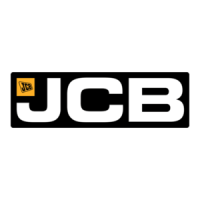
Do you have a question about the jcb 4160 and is the answer not in the manual?
Guidance on safe operation, understanding warnings, and maintaining the manual.
Importance of dealer explanation for new machines, productivity, and performance.
Provides information on models, using the manual, left/right definition, and cross-references.
Defines 'left' and 'right' as per operator's seating position in the machine.
Explains how cross references are presented in the manual for easy navigation.
Specifies the manual's location within the machine for easy access and return.
Emphasizes hazards of machinery and the importance of understanding and following warnings.
Explains signal words like DANGER, WARNING, CAUTION, and Notice used in safety notices.
Covers training, care, alertness, clothing, alcohol, drugs, feeling unwell, mobile phones, raised equipment, lightning, and modifications.
Advises on appropriate clothing and PPE to prevent injury from machinery.
Advises familiarizing oneself with machine operation, controls, gauges, and asking dealers for clarification.
Provides the manufacturer's name and address for reference.
Discusses compliance with laws and regulations at the time of manufacture and re-sale considerations.
Describes the machine as a self-propelled wheeled tractor for agricultural use, its road circulation design, and SCR technology.
Specifies the machine's intended use for agricultural applications and warns against misuse in dangerous environments.
Defines the danger zone around the machine where moving parts can cause injury and advises keeping persons out.
Identifies front components of the tractor using diagrams and labels.
Details the machine's identification plate, VIN, and typical product identification numbers.
Describes the engine data plate location and content, including identification numbers.
Explains that axles have serial numbers stamped on a data plate.
States the gearbox serial number is stamped on a data plate.
Warns about operating with damaged ROPS/FOPS and the necessity of wearing a seat belt for protection.
Details compliance with ROPS standards and cab identification procedures.
Addresses the risk of falling objects and the availability of FOPS for agricultural and forestry applications.
Advises on cab glazing limitations and the need for additional protection against penetrating objects.
Explains the purpose of safety labels, their strategic placement, and the importance of keeping them clean and readable.
Instructs on replacing missing or damaged safety labels and identifying them by part number.
Identifies various components within the operator station using a detailed diagram and labels.
Explains the operation of the three-position ignition switch and its functions.
Details the functions of the multi-purpose switch for direction indicators and windscreen wipers.
Describes how to activate the windscreen washer system.
Explains how to operate the vehicle's horn.
Details how to switch between headlight dip beam and main beam, including flashing the main beam.
Explains the automatic operation of cab and step lights and how to manually control them.